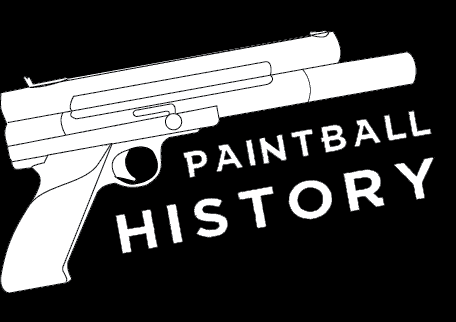
Bob Gurnsey, Paintball’s creator passed away Monday, August 24rd, 2015.
An obsession between Gurnsey and his two close friends, Hayes Noel and Charles Gaines, over what life style would be best suited for victory in a “Survival Game” challenge amounted to the first organized game of Paintball in June of 1981.
Read about Bob telling that story to Randy Kamiya, of Action Pursuit Games, which was printed in September of 1992 at:
https://paintballhistory.com/bob-gurnsey-paintball-creators-memorabilia
I never had the chance to meet Bob, but thanks to Tina “Golden Girl” Ruzzo, I was fortunate enough to speak with him on the phone multiple times over the last few years. We spoke about paintball as well as life lessons Bob learned and how he saw himself as not just as paintball’s creator, but as an American entrepreneur. I took notes on many of our conversations but since I never had a chance to meet with Bob, I wasn’t able to interrogate him with a barrage of questions in a video interview.
Luckily, there are others that did record their conversations with Bob. Some of these are in the playlist below. Thanks to Tom “TomCat” Cunningham, of Catshack Reports, and others who posted videos on Bob’s plethora of stories.
My first conversation with Bob was in late 2012 or early 2013. During our first talk, I asked for his permission to upload a National Survival Game Rapide Promo video to youtube. In this video we can see the pace of a 1988-1989 game in the woods, run entirely with Splatmasters and Rapides. Pretty much every paintball enthusiast’s dream!
Although I am somewhat of a newcomer to paintball, starting in 1998/99 with a Model 98, rather than 1985 with a Nelspot, PG, or Splatmasters, I was able to enjoy my share of NSG Splatmaster games at Peter Simpson’s Clarksburg Pump Days. From these games I not only have a respect for NSG for building such a durable entry level paintgun, but can also see the sleekness of the Splatmaster when placed besides comparable paintguns of the time, such as the Nelspot 007 or the Sheridan PMI PG.
But most Splatmasters and Rapides today suffer from worn components. But as a testament to their quality, they don’t actually break. Over a million of Splatmasters were produced in the 1980s and likely hundred of thousands of Rapides (if not over a million) were made as well. In the second part of Bob Gurnsey’s 1992 APG interview with Randy Kamiya (published October 1992) he talks about building a paintgun out of plastic polymers.
Bob says, explaining a conversation to the engineer of the Splatmasters in 1983:
“I told him that I didn’t want to make the gun out of metal. I wanted him to make it out of plastic. But not cheap plastic, polymers. And he said, “What!? There are no plastic guns out there!” I said, “I know, but I want to make one.””
And 5 years later, in 1988, NSG innovated again, with what would be the first .68 caliber double action paintball marker that made it to market.
Sure, the AGA .62 cal pistol and other revolver pistols were double action, but these were .50 or .62 cal. The Joe Survival Mark V pistol is one example of these.
The Innovative and Low Cost National Survival Games Rapide
The Rapide was cutting edge when released in the summer of 1988. No, not for it’s speed (it really wasn’t too quick even for the low standard of 1988/89) but for a variety of other reasons that appealed to fields looking for a quality rental marker that they could offer new comers, and to new players and outlaw paintballers who just wanted a less expensive, easy to maintain paintgun to play the survival game with.

Double Action:
The trigger in the Rapide was one of the first double actions used in paintball. Although it was advertised as a semi automatic, the Rapide, and other double actions, actually use the pull of the trigger to move the hammer back and then releases the hammer to fire the paintball, all in one stroke.
Other .68 caliber double actions of the time, include the never released U.S.A. Crossfire and the Brass Eagle Jaguar, which debuted slightly later.
The Rapide also featured one of the first bulk loaders:
The Loader on the Rapide held 4 stacks of 5 paintballs, making the total ball count 20. And with a simple rotation, the stack could be reloaded. Once the clip was empty, it could be slid off and another clip slid on.

Incredibly Cheap Cost:
Bob didn’t mention production costs of the Rapide during our conversations, but he did explain that Splatmasters were very low cost to produce, which lead to their low retail price.
The “fiber reinforced” exterior and internal plastic pieces of the National Survival Games paintguns were produced in Arkansas, at Gurnsey’s Culpepper Plastics Corp (CPC) and then assembled at National Survival Games in New Hampshire.
I would imagine the mass quantity of the NSG guns produced, along with not having to subcontract the extremely durable plastic components, were what led to the Splatmasters and Rapides affordable prices.
Looking at prices in the October 1989 issue of Action Pursuit Games, the Rapide must have been cheap for NSG to produce.
Retailing on average at $99.99 (Adventure Game Supply, Joliet Army Supplies, Ground Zero, and I&I sports offered them at $95.00 but without free shipping). Compared to the other advertised paintguns, the Nelspot 007 was at $90-99.99, the only other double action released at the time, the Brass Eagle Jaguar, was at about $275-300. The Sniper 1 was at $369.95 to 400.
“Splat Power!”:
Although plastic externally, the Rapide did incorporated a “polished brass inner barrel” (bore), which Bob explains, “Guarantees tight shot groups and dependable “splat” power.”
The Rapide went on to likely sell hundreds of thousands and even gain recognition from the firearm industry, earning NSG the American Firearms Industry “Product Award of Merit” in 1989.
The Rapide helped bring many individuals into paintball by provided a cheap but reliable paintgun.
In the second segment of Randy Kamiya’s interview with Bob Gurnsey, which was published in the October 1992 issue of Action Pursuit Games, Bob explains his decision to protect the expansion of the game. Saying a similar quote to what he had told me in our phone conversions.
Randy quote’s Bob as says:
“…I would like to have a ten percent market share of something 100 time bigger rather than 100 percent of the current market…”
And NSG did have the largest market share of field franchises, paintguns sold, paint sales, goggles, and more, during likely most of Paintball’s first decade, but unfortunately with the largest share of the market came the largest share of the problems.
Bob told me that he had to deal with 103 lawsuits over the years. But even though National Survival Games never lost in court, the first 55 or 60 lawsuits had an an average cost of winning at 97 thousand dollars each. As Bob put it, “Every time I won i lost.”

In early 1990 NSG lost their insurance and left Bob was left to combat the remaining 35 million in lawsuits himself. After loosing their insurance, NSG ceased development of new products. Products after this point were released by GFR Corp (GZ) but I would imagine that research and development was massively scaled back.
Blow after blow, Bob never stopped fighting, even when he was diagnosed with Leukemia in 2003. And talking to Bob on the phone, you could tell he still loved the Survival Game, despite the set backs over the years.
Bob you will be remembered by paintballers around the world who are grateful for your contributions.
Find Bob’s parting message on his site at:
http://www.bobgurnsey.com/about.html
And follow more updates from Bob’s family, and about Bob’s history on Paintball Creator’s facebook:
https://www.facebook.com/paintballcreatormemorabilia
And find the first portion of his 1992 APG interview with Randy Kamiya, which I posted earlier this year at:
https://paintballhistory.com/bob-gurnsey-paintball-creators-memorabilia
I’ll eventually be posting the second portion of scans of Randy Kamiya and Bob Gurnsey’s 1992 interview as well as more information on the Prototype Rapide. Later this year or next year I’ll document airing up and shooting the Rapide prototype as well as a few other interesting NSG guns which Bob sold me earlier this year.








“Bob told me that he had to deal with 103 lawsuits over the years. But even though National Survival Games never lost in court, the first 55 or 60 lawsuits had an an average cost of winning at 97 thousand dollars each. As Bob put it, “Every time I won i lost.””
I had no idea the cost and effort Bob went through to bring paintball to the public. This only makes me appreciate his contribution to paintball more. First rounds on me at the Pearly Gates, Bob. Thanks again.
Jacen Bob told me pretty much the same thing. You see I met Bob through a auction on guns america. He was trying to sell a ruger 22.mag that his uncle had left him. To make a long story short I bought the gun and made one great friend. I used to call him or he used to call me that is until he became to sick. I still have all the e-mails he sent. I miss our talks,, he was such an interesting person.